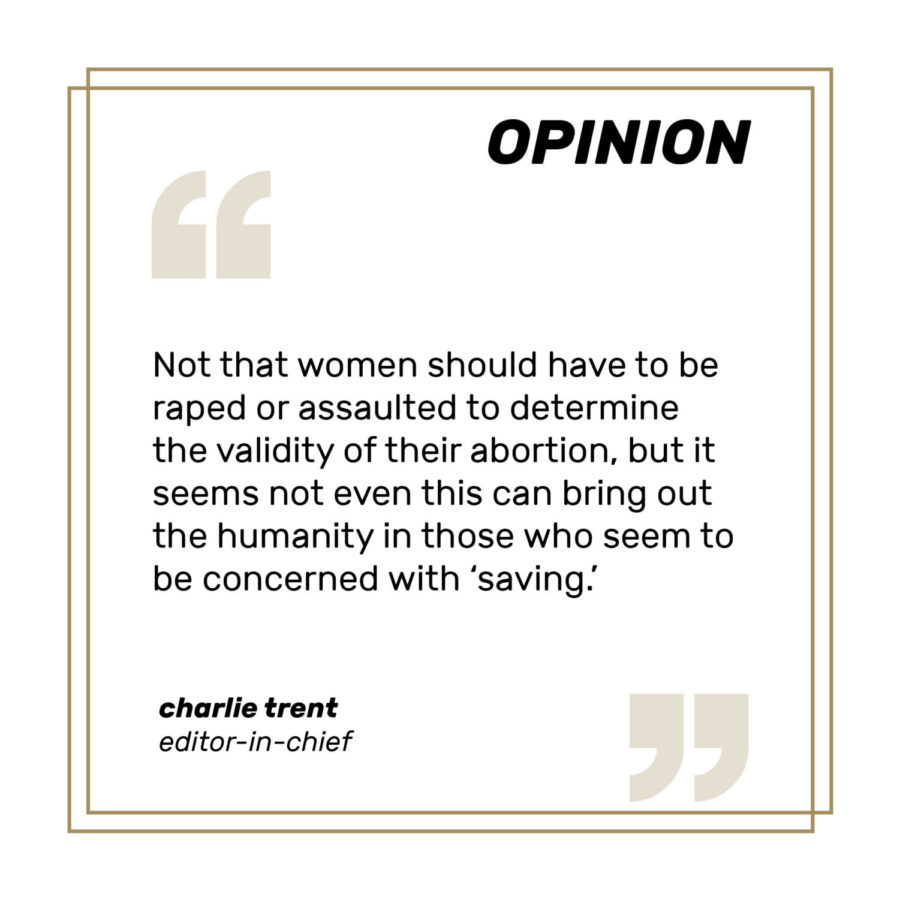On Reproductive Rights: Potential Overturning of Roe v. Wade
What you need to know about current discussions about reproductive rights in the Supreme Court, and how these decisions affect you as a resident of Overland Park
As is expected due to the volume of social media presence in our societal interpretation of activism, many teens have likely seen a surge of opinions and infographics plastered across their Twitter feed and Instagram stories regarding abortions in the United States.
Typical with these performative infographics, there is little actual information illustrating the details of the case, the future of reproductive rights or how it may influence the lives of adolescents emerging into adulthood.
In order to understand the weight of the potential overturning of the Supreme Court Roe v. Wade decision, it’s essential to begin with comprehending the original case.
Roe v. Wade 1973
According to Oyez, “In 1970, Jane Roe (a fictional name used in court documents to protect the plaintiff’s identity) filed a lawsuit against Henry Wade, the district attorney of Dallas County, Texas, where she resided, challenging a Texas law making abortion illegal except by a doctor’s orders to save a woman’s life. In her lawsuit, Roe alleged that the state laws were unconstitutionally vague and abridged her right of personal privacy, protected by the First, Fourth, Fifth, Ninth, and Fourteenth Amendments.”
Jane Roe sued following the birth of her son whom she did not want to have and his subsequent adoption because she was kept from having an abortion, leading to an influx of nationwide support, chiefly hailing from women. Signs were sported outside of the court from pro-life supporters, such as “The right to abort belongs to GOD, NOT us,” and “Adoption not Abortion.”
Nevertheless, the case passed with a stunning majority of 7-2, changing the landscape of reproductive rights in America.
The case brought about the ability for women to have a medical abortion performed legally in the first trimester, and put considerable restrictions on many sort of government intervention. The case essentially removed the power from the hands of state and local government officials and transferred these rights to the federal government.
Counter-movements continued to gain popularity following the trend of gradual political polarization in the United States, and while Roe v. Wade has continuously been challenged and debated in hopes that the decision would be heard once again, the potential overturning of the case was not a very possible threat until May 2, 2022, when, according to Politico, an “initial draft majority opinion written by Justice Samuel Alito circulated inside the court and obtained by Politico.”
The drafted response is in favor of striking down the decision, as well as Planned Parenthood v. Casey, a 1992 decision which supported the aforementioned decision.
If the case is overturned, the power to place restrictions on first trimester abortions would be returned to the state, allowing local jurisdictions to decide for themselves based on a vote.
According to Politico, it is expected that if the law was to be overturned, 26 out of 50 states would outlaw abortion.
How does this affect Kansas Residents?
In many Southern states, the prevailing Conservative political government leaders have the potential to lead the south into an all but impossible situation for those seeking abortions.
In Oklahoma, Gov. Kevin Stitt signed the Oklahoma Heartbeat Act, prohibiting abortions after about six weeks of pregnancy which was modelled after a similar bill in Texas.
This decision, signed into law as of last year, denies abortions after fetal cardiac activity is detected and requires enforcement of this procedure from civilians in the community rather than government officials.
In Kansas, there is potential for reproductive rights to be threatened, though previously they were protected by lawmakers. In 2019, the Kansas Supreme Court ruled to uphold Roe v. Wade, increasing backlash from champions of the Pro-Life movement.
However, if the initial draft of the issue on abortion is any foresight on what’s to come, Kansas will see a vote in August to decide if the Constitution can allow for abortion rights.
This will be placed on the primary ballot.
According to a poll collected by Fort Hays State University, “Over 60% of residents oppose making abortion completely illegal in Kansas, even in instances of rape or incest.” This kind of skewed opinion leads experts to believe voting turnout will surge in the 2022 election across the state.
As of 2019, abortions after 22 weeks are illegal in Kansas; however, the first trimester is vulnerable if there is an amendment made with the potential overturn.
Why You Should Support Roe v. Wade
Now that the facts about the impending possibility of the future of reproductive rights, I feel it’s essential to explain the gravity of the importance of support surrounding the cause to preserve these rights.
According to the CDC, in 2019, “92.7% of abortions were performed at ≤13 weeks’ gestation,” with over half (56.9%) of women having them performed being in their 20s.
In this same year, “42.3% of all abortions were early medical abortions.”
Finally, according to the World Health Organization, “Around 73 million induced abortions take place worldwide each year. Six out of 10 (61%) of all unintended pregnancies, and 3 out of 10 (29%) of all pregnancies, end in induced abortion (1).”
If not made already abundantly clear by these statistics, abortions will not be removed from the United States. Instead, they will cause unnecessary pain, death and trauma for child bearing peoples across the nation — for what? The study done by the CDC more than 45 years ago outlines the impossibility of this reasoning.
“In a 1976 article, researchers from the Center for Disease Control examined national abortion data from the three years surrounding the rulings and estimated that the number of illegal procedures in the country plummeted from around 130,000 to 17,000 between 1972 and 1974. The number of deaths associated with illegal abortion decreased from 39 to 5 in that same time period; women who died as a result of illegal abortions typically were black, were more than 12 weeks pregnant and had self-induced in their own community.
Researchers concluded abortion services need to be improved and available more widely, especially for women at high risk for seeking illegal abortions because “any actions which impede their access to legal abortion may increase their risk of death.”
Read that again.
Women, especially women of color, are lost simply trying to have an abortion when the means to a safe procedure are not available.
Despite what Christian conservatives may want you to believe, sacrificing the life of a mother, or even subjecting a child to the unsafe and unsuitable circumstances they might be born into, is not the morally righteous decision. It’s cruel.
In addition to the plainly unjust subjection of a woman to motherhood and stripping her of her bodily autonomy by denying her the right to an abortion, there is also the extenuating circumstance of women who actually want to have children but must have an abortion for the sake of staying alive in the case of an unsfe pregnancy.
According to Mayo Clinic, “An ectopic pregnancy occurs when a fertilized egg implants and grows outside the main cavity of the uterus.” This condition can be fatal — the cure is having an abortion.
This specific issue is only one particular case in which abortion could medically save the life of an individual, but there is also the consideration of the manner in which the child itself was conceived which may lend the mother to be in favor of having an abortion.
For instance, non-consentual sex.
Rape is extremely traumatic, and in the case of young girls — who make up the majority of the statistics of those who receive abortions and those who are raped — abortions have the potential to provide relief and removal of these traumatic events.
According to VictimsOfCrime.org, an original study from 1986 — confirmed by later studies in 2000, 2002 and 2005 — one in five girls is a victim of sexual abuse.
When sexual abuse is so prevalent in our culture where women are stripped of their bodily autonomy, why should women also be denied of their right to determine the fate their bodies by the government?
Not that women should have to be raped or assaulted to determine the validity of their abortion, but it seems not even this can bring out the humanity in those who seem to be concerned with “saving.”
With this information, I hope to impress upon my peers the importance of voting in the primary election in August, as the ballot for this issue will be a part of it.
And please — for the future of our country — consider the facts.

Charlie Trent is editor-in-chief and is a senior. It is her fourth year on staff. In school, she is involved in Chambers singers as Dance Captain and Choir...




